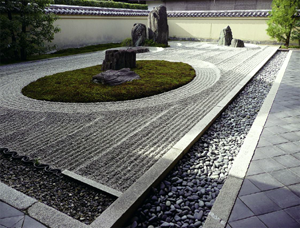POSTSCRIPT
A LEAF
In a certain sense, the Zen garden is like a haiku. The very intuition of the instant is a form of narration, abstracted from the flux of time’s passing, yet revealing the poignancy and profundity of the ephemeral. Equivocal spatiality and polymorphous temporality are unified and surpassed in a flash of inspiration, where metaphors ultimately disappear. Such intuition takes the narrative form not of the epic or the romance but of the haiku, depicting the few seconds that it takes a leaf to fall within the confines of the most durable gardens in history. The Zen garden is variously described as the site that makes possible such intuition, a symbol of this intuition, or as a manifestation of the intuition itself. It is all this, and more.
There is an oft-told story about Sen no Rikyū that exists in many versions, perhaps most famously in Okakura Kakuzō’s The Book of Tea. One autumn day Rikyū watched as his son Shōan swept and watered the garden path. ‘Not clean enough’, insisted the master, time and again. After an hour, his son replied: ‘Father, there is nothing more to be done. The steps have been washed for the third time, the stone lanterns and the trees are well sprinkled with water; moss and lichens are shining with a fresh verdure; not a twig, not a leaf have I left on the ground.’ In response Rikyū exclaimed: ‘Young fool, this is not the way a garden path should be swept’, upon which he shook a maple tree, randomly scattering its crimson leaves.1 Rikyū’s famed pupil, Oribe, one of the greatest tea masters, went so far in his mannerism as to sweep his garden clean of leaves, and then sprinkle pine needles under deciduous trees. These tales have never been forgotten.
My first visit to Ryōgen-in took place early one morning in December 2007. The garden, brilliant in the matinal sunlight, revealed a curious detail: a single crimson maple leaf lay just alongside the left-most rock group. It is almost inconceivable that this could have been an omission during the morning cleaning because the autumnal maple leaf is revered in Japan, the subject of the greatest attention and admiration. Furthermore, nature herself could not have brought this gift, since the entire morning was of the utmost calm. One could only deduce that the novice, monk or gardener entrusted with cleaning and raking the garden that day – conscious or not of the famed tale of Rikyū – had placed this leaf on the otherwise immaculate gravel surface, perhaps in imitation of the unpredictable quality of nature, perhaps as a minimal and mannerist aesthetic gesture. This single leaf refocused the entire garden, not unlike the jar on a hill in Tennessee celebrated in the first stanza of Wallace Stevens’s poem, ‘Anecdote of the Jar’.2 According to Zen aesthetics, the presence of this solitary leaf might suggest a drastic, even if ephemeral and aleatory, reconstitution of this garden’s already sublime aesthetics. The brief moment of its fall unveils the potentiality of time, and its short trajectory traces the malleability of space. In the Zen garden, the fall of a leaf, a sudden rain, a ray of sunlight, a moonbeam, may offer aesthetic, religious or utopian possibilities hitherto unimaginable.
Ryōgen-in, a subtemple of Daitoku-ji.
